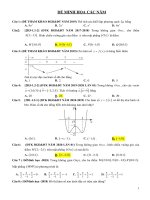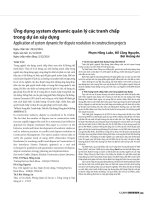Effects of growth temperature on morphological and structural properties of ZnO films
Bạn đang xem bản rút gọn của tài liệu. Xem và tải ngay bản đầy đủ của tài liệu tại đây (570.05 KB, 6 trang )
JOURNAL OF TECHNOLOGY EDUCATION SCIENCE
Ho Chi Minh City University of Technology and Education
Website: />Email:
ISSN: 2615-9740
Effects of Growth Temperature on Morphological and Structural Properties
of ZnO Films
Vo Doan Thanh Truong, Thi Thanh Truc Nguyen, Thanh Lan Vo,
Hoang Trung Huynh, Thi Kim Hang Pham*
Faculty of Applied Sciences, Ho Chi Minh University of Technology and Education, Ho Chi Minh City, Vietnam
*
ARTICLE INFO
Corresponding author. Email:
ABSTRACT
Received:
29/06/2022
Revised:
23/08/2022
Accepted:
22/09/2022
Published:
28/10/2022
KEYWORDS
Zinc Oxide;
ZnO;
Thin films;
RF-magnetron sputtering;
Growth temperature.
Zinc oxide (ZnO) is one of the most promising oxide possibilities for use in
a number of industries due to its unique properties. Because of its broad direct
bandgap (3.37 eV) and strong exciton binding energy (60 meV) at ambient
temperature, ZnO not only conducts electricity well but also transmits visible
light and emits UV light. Here, we investigated the effect of growth
temperature on ZnO thin films by changing the growth temperatures from
400 oC to 450 oC. Radio-frequency (RF) magnetron sputtering was used to
create ZnO thin films on Si(100) substrates. The atomic force microscopy
(AFM) results show that the root-mean-square (RMS) roughness decreases
from 6.1 ± 1.0 nm to 4.8 ± 0.6 nm as the growth temperatures increase. The
crystalline structures of ZnO films strongly depend on the growth
temperature. Our findings indicate that controlling the growth temperature is
the critical factor in producing high-quality ZnO thin films.
Doi: />Copyright © JTE. This is an open access article distributed
under the terms and conditions of the Creative Commons Attribution-NonCommercial 4.0
International License which permits unrestricted use, distribution, and reproduction in any medium for non-commercial purpose, provided the original work is
properly cited.
1. Introduction
ZnO is a II-VI semiconductor compound that has attracted the interest of scientists in a variety of
applications, such as blue optoelectronics, ultra-violet (UV) detectors and emitters, transparent
conducting electrodes and chemical and biosensors owing to its properties [1-3]. ZnO exhibits a wide
direct bandgap of 3.37 eV and large exciton energy of 60 meV at room temperature. Moreover, ZnO has
important optical properties such as good visible light transmission, UV light emission and lasing action
[2, 4, 5]. Therefore, ZnO has emerged as one of the most promising oxide materials and has been studied
in different nanostructures such as nanoparticles, nanotubes, nanorods, and thin films to apply for
various purposes in life.
Recently, ZnO thin film has been deposited on silicon substrate for NO2 and glucose sensors [6, 7],
Schottky photodiodes [8-10], piezoelectric generators [11, 12] and solar cells [13, 14] applications.
However, using ZnO thin films in these devices is difficult because achieving a high-quality ZnO thin
film on a silicon substrate is difficult due to lattice mismatch. The differences in lattice constants and
crystal structure between the silicon substrate (cubic, aSi = 0.543 nm [15]) and ZnO thin film (hexagonal,
aZnO = 0.325 nm , cZnO = 0.521 nm [1]) strongly affect the microstructure and morphology of ZnO thin
film. Consequently, it will decrease the performance of electronic devices.
Growth temperature provides energy for atoms to occupy the preferential sites. By controlling the
growth temperature, ZnO thin films will have differences in crystallinity and surface properties [16-18],
stoichiometry (Zn-rich or O-rich) and native defects (oxygen vacancy, zinc vacancy, oxygen interstitial,
zinc interstitial) [19]. Moreover, the crystalline quality of ZnO films strongly depends on the deposition
method. From the literature, the crystalline structure of ZnO films was decreased with the growth
temperature of 600 oC by using the physical vapor deposition method [20, 21]. ZnO thin films were
JTE, Issue 72A, October 2022
39
JOURNAL OF TECHNOLOGY EDUCATION SCIENCE
Ho Chi Minh City University of Technology and Education
Website: />Email:
ISSN: 2615-9740
grown by e-beam evaporation in the range from room temperature to -120 °C [22]. In this work, the RFmagnetron sputtering method was utilized to fabricate ZnO thin films on Si (100) substrates with the
growth temperature ranging from 400 °C to 450 °C. The dependence of structural and morphological
properties of ZnO thin films on growth temperature was mainly studied.
2. Experimental
ZnO thin films were prepared by radio frequency (RF)-magnetron sputtering on Si(100) substrates
by using ZnO target. The Si(100) substrate was cleaned by rinsing in deionized water (DI), isopropyl
alcohol (IPA), H2SO4 5%, and HF 20% solution. Si(100) substrate was pre-heated in the vacuum
chamber at a pressure of 7.5×10-6 Torr to remove contamination and water vapor still clinging to the
substrate’s surface. The ZnO thin films were deposited on Si(100) substrate at various growth
temperatures: 400 °C (Tg400), 425 °C (Tg425) and 450 °C (Tg450).
X-ray diffraction (XRD) was used to analyze the crystalline structure of ZnO thin films. The
morphology of ZnO samples was investigated by Atomic Force Microscopy (AFM). The surface
properties can be obtained by using ScanAsyst in air mode with a scanning side of 1 àm ì 1 àm and a
scan rate of 0.7 Hz.
3. Results and discussions
To understand the effect of the growth temperature on the morphology of ZnO samples, the AFM
scan was used to measure the root-mean-square (RMS) roughness of ZnO films. The AFM scans of ZnO
samples (Tg400, Tg425 and Tg450) are shown in Fig. 1. ZnO thin films exhibit large platelet-like arrays
and uneven tiny grains. When the growth temperature increases, the number of small grains decreases
and the arrays are more closely packed (see Fig. 1). Sample Tg400 has the roughest RMS roughness,
with a RMS roughness of 6.1 ± 1.0 nm, while the RMS roughness values of samples Tg425 and Tg450
decrease to 5.4 ± 1.2 nm and 4.8 ± 0.6 nm. Table 1 summarizes the results obtained using AFM scan for
three different growth temperatures of ZnO thin films.
Fig. 2 represents the profile height of samples Tg400, Tg425 and Tg450. All the profile heights of
ZnO thin films exhibit many little splitting peaks. The splitting peak phenomenon in these samples
shows the existence of many small grains on the platelet-like arrays. These tiny grains are also uneven,
which is illustrated by the irregularity of the splitting peaks of the line profile. The peaks of sample
Tg400 are the highest compared to the remaining ZnO samples, up to 48 nm high (see Fig. 2a). The high
RMS roughness value of 6.1 ± 1.0 nm can result from the high and irregular peaks of ZnO thin films
grown at 400 C.
(a)
(b)
(c)
Fig 1. AFM scans (1àm ì 1àm) of ZnO samples (a): Tg400; (b): Tg425 and (c): Tg450. The black dashed line in
each AFM scan at 0.5 µm represents the profile height (Fig. 2).
JTE, Issue 72A, October 2022
40
JOURNAL OF TECHNOLOGY EDUCATION SCIENCE
Ho Chi Minh City University of Technology and Education
Website: />Email:
ISSN: 2615-9740
(a)
(b)
(c)
Fig 2. The profile height of samples (a): Tg400; (b): Tg425 and (c):Tg450.
Table 1. Morphology analysis of the AFM scans for samples Tg400, Tg425 and Tg450.
Samples
Growth temperature (°C)
RMS Roughness (nm)
Peak-to-valley height (nm)
Tg400
400
6.1 ± 1.0
29.1 ± 5.4
Tg425
425
5.4 ± 1.2
26.3 ± 5.4
Tg450
450
4.8 ± 0.6
24.9 ± 3.3
After the morphology characterization, the structural properties of ZnO thin films were measured by
using XRD. Fig. 3 displays XRD patterns of samples Tg400, Tg425, and Tg450, respectively.
Tg400, Tg425 and Tg450 samples all exhibit various diffraction peaks such as ZnO(100), ZnO(002),
ZnO(103), and ZnO(004). These peaks of ZnO thin films go in line with the hexagonal wurtzite phase
[16, 23]. The FWHM values of the diffraction peaks for the (002) plane for samples Tg400 and
Tg425 are 0.236° and 0.251°, respectively, which are larger than that of sample Tg450 (0.226°) (see
Table 2). The FWHM of ZnO samples reveals that the crystallinity of ZnO thin films is enhanced by
increasing the growth temperatures. The growth temperature obviously helps to increase the crystalline
quality of ZnO thin films, which agrees with previous reports [16-18]. The increased crystallinity of
ZnO thin films due to the growth temperature can be explained by the atomic mobility [19]. At higher
growth temperatures, the thermal energy increases the mobility of the atoms and helps them occupy the
preferential position for good crystallinity [24].
Moreover, there is a shift of the ZnO(002) peaks to higher angles than the bulk values (34.4°) [18]
(Table 2). The interplanar spacing of plane (d-spacing) values of ZnO thin films are figured out by using
the Bragg equation [25]:
2𝑑𝑠𝑖𝑛𝜃 = 𝑛λ
(1)
With 𝜃, 𝑛, λ is corresponding to diffraction Bragg angle, diffraction order (n = 1), and x-ray’s
wavelength (λ = 1.54 Å).
When the growth temperature increases, the d-spacing values decrease from 2.600 to 2.593 Å,
indicating the presence of compressive strain in ZnO thin films [26]. These strains are the reason for the
shift of the ZnO (002) peaks of ZnO thin films to higher positions [27].
JTE, Issue 72A, October 2022
41
JOURNAL OF TECHNOLOGY EDUCATION SCIENCE
Ho Chi Minh City University of Technology and Education
Website: />Email:
ISSN: 2615-9740
Fig 3. XRD spectra of samples Tg400, Tg425, and Tg450.
Table 2. Information about structural properties obtained from the XRD spectra.
(002) peak information
Samples
(h k l)
Experimental (°)
Bulk (°)
FWHM (°)
d-spacing
(Å)
Tg400
(0 0 2)
34.46
34.4
0.236
2.600
Tg425
(0 0 2)
34.49
34.4
0.251
2.598
Tg450
(0 0 2)
34.53
34.4
0.226
2.595
4. Conclusions
In summary, ZnO films were deposited on Si(100) substrates using RF-magnetron sputtering. The
growth temperatures of ZnO thin films range from 400 oC to 450 oC. The effect of growth temperature
on the microstructure and morphology of ZnO thin films is investigated. The AFM result reveals that
the RMS roughness of ZnO thin film deposited at 450 oC is the smallest and the platelet-like arrays are
more densely packed. In addition, XRD patterns exhibit an improvement in the structure of ZnO films.
Our results indicate that the growth temperature of 450 oC is the optimal condition for growing the highquality ZnO thin films. It will be suitable for application in the fabrication of nanodevices.
Acknowledgments
This work belongs to the project grant No: SV2022-82 funded by Ho Chi Minh City University of
Technology and Education, Vietnam.
JTE, Issue 72A, October 2022
42
JOURNAL OF TECHNOLOGY EDUCATION SCIENCE
ISSN: 2615-9740
Ho Chi Minh City University of Technology and Education
Website: />Email:
REFERENCES
[1]
[2]
[3]
[4]
[5]
[6]
[7]
[8]
[9]
[10]
[11]
[12]
[13]
[14]
[15]
[16]
[17]
[18]
[19]
[20]
[21]
[22]
[23]
[24]
[25]
[26]
[27]
S. Vyas, "A Short Review on Properties and Applications of Zinc Oxide Based Thin Films and Devices: ZnO as a promising material for
applications in electronics, optoelectronics, biomedical and sensors," Johnson Matthey Technology Review, vol. 64, no. 2, pp. 202 - 218,
2020.
M. A. Borysiewicz, "ZnO as a Functional Material, a Reviews," Crystals, vol. 9, no. 10, p. 505, 2019.
C. Klingshirn, "ZnO: Material, Physics and Applications," Chem. Phys. Chem, vol. 8, pp. 782-803, 2007.
Y. Zhi-Gang, Z. Xi-Qing, S. Hong-Kai, T. Xiao-Ying, W. Yong-Sheng, and H. Shi-Hua, "Lasing action of high quality ZnO thin film
deposited by radio-frequency magnetron sputtering," Chinese Physics, vol. 14, no. 6, pp. 1205-1208, 2005.
Alsultan Abdulkareem Ghassan, Nurul-Asikin Mijan, and Y. H. Taufiq-Yap, "Nanomaterials: An Overview of Nanorods Synthesis and
Optimization," in Nanorods and Nanocomposites, Morteza Sasani Ghamsari and S. Dhara, Eds.: Intech Open, pp. 1 - 24, 2020.
J. Ghosh, R. Ghosh, and P. K. Giri, "Tuning the visible photoluminescence in Al doped ZnO thin film and its application in label-free
glucose detection," Sensors and Actuators B: Chemical, vol. 254, pp. 681-689, 2018.
S. I. Boyadjiev, V. Georgieva, R. Yordanov, Z. Raicheva, and I. M. SzilĂ¡gyi, "Preparation and characterization of ALD deposited ZnO
thin films studied for gas sensors," Applied Surface Science, vol. 387, pp. 1230-1235, 2016.
G. M. Ali, "Performance analysis of planar Schottky photodiode based on nanostructured ZnO thin film grown by three different
techniques," Journal of Alloys and Compounds, vol. 831, p. 154859, 2020.
L. Rajan, C. Periasamy, and V. Sahula, "Electrical characterization of Au/ZnO thin film Schottky diode on silicon substrate," Perspectives
in Science, vol. 8, pp. 66-68, 2016.
A. B. Yadav, A. Pandey, D. Somvanshi, and S. Jit, "Sol-Gel-Based Highly Sensitive Pd/n-ZnO Thin Film/n-Si Schottky Ultraviolet
Photodiodes," IEEE Transactions on Electron Devices, vol. 62, no. 6, pp. 1879-1884, 2015.
P.-C. Lee, Y.-L. Hsiao, J. Dutta, R.-C. Wang, S.-W. Tseng, and C.-P. Liu, "Development of porous ZnO thin films for enhancing
piezoelectric nanogenerators and force sensors," Nano Energy, vol. 82, p. 105702, 2021.
W. Qin et al., "A high power ZnO thin film piezoelectric generator," Applied Surface Science, vol. 364, pp. 670-675, 2016.
S. Chala, N. Sengouga, F. Yakuphanoğlu, S. Rahmane, M. Bdirina, and İ. Karteri, "Extraction of ZnO thin film parameters for modeling
a ZnO/Si solar cell," Energy, vol. 164, pp. 871-880, 2018.
P. Fallahazad, N. Naderi, M. J. Eshraghi, and A. Massoudi, "Combination of surface texturing and nanostructure coating for reduction of
light reflection in ZnO/Si heterojunction thin film solar cell," Journal of Materials Science: Materials in Electronics, vol. 29, no. 8, pp.
6289-6296, 2018.
D. Kumar and M. Johari, "Characteristics of silicon crystal, its covalent bonding and their structure, electrical properties, uses," AIP
Conference Proceedings, vol. 2220, no. 1, p. 040037, 2020.
T. P. Rao, M. C. S. Kumar, S. A. Angayarkanni, and M. Ashok, "Effect of stress on optical band gap of ZnO thin films with substrate
temperature by spray pyrolysis," Journal of Alloys and Compounds, vol. 485, no. 1, pp. 413-417, 2009.
F. Zahedi, R. S. Dariani, and S. M. Rozati, "Effect of substrate temperature on the properties of ZnO thin films prepared by spray pyrolysis,"
Materials Science in Semiconductor Processing, vol. 16, no. 2, pp. 245-249, 2013.
S. Singh, R. S. Srinivasa, and S. S. Major, "Effect of substrate temperature on the structure and optical properties of ZnO thin films
deposited by reactive rf magnetron sputtering," Thin Solid Films, vol. 515, no. 24, pp. 8718-8722, 2007.
S. Mishra et al., "Structural Properties of Thin ZnO Films Deposited by ALD under O-Rich and Zn-Rich Growth Conditions and Their
Relationship with Electrical Parameters," Materials, vol. 14, no. 14, 2021.
S. Cho, "Structural and optical properties of ZnO films grown on sapphire substrates subjected to substrate temperature," Journal of the
Korean Physical Society, vol. 49, no. 3, pp. 985-988, 2006.
D.-K. Kim and C.-B. Park, "Deposition of ZnO thin films on Si by RF magnetron sputtering with various substrate temperatures," Journal
of Materials Science: Materials in Electronics, vol. 25, no. 12, pp. 5416-5421, 2014.
C. Morales et al., "Growth and characterization of ZnO thin films at low temperatures: from room temperature to -120 °C," Journal of
Alloys and Compounds, vol. 884, p. 161056, 2021.
Chang-Sik Son et al., "Deposition-temperature dependence of ZnO/Si grown by pulsed laser deposition," Journal of the Korean Physical
Society, vol. 45, pp. S685 - S688, 2004.
Y. Liang et al., "Growth Mechanisms and the Effects of Deposition Parameters on the Structure and Properties of High Entropy Film by
Magnetron Sputtering," Materials, vol. 12, no. 18, 2019.
H. Ennaceri et al., "Influence of stress on the photocatalytic properties of sprayed ZnO thin films," Solar Energy Materials and Solar
Cells, vol. 201, p. 110058, 2019.
S. Youssef, P. Combette, J. Podlecki, R. A. Asmar, and A. Foucaran, "Structural and Optical Characterization of ZnO Thin Films Deposited
by Reactive rf Magnetron Sputtering," Crystal Growth & Design, vol. 9, no. 2, pp. 1088-1094, 2009.
B. D. Cullity, "Structure of Polycrystalline Aggregates," in Elements of x-ray diffraction2nd ed. Reading, MA: Addison-Wesley Publishing
Company, Inc., pp. 281 - 323, 1978.
JTE, Issue 72A, October 2022
43
JOURNAL OF TECHNOLOGY EDUCATION SCIENCE
Ho Chi Minh City University of Technology and Education
Website: />Email:
ISSN: 2615-9740
Vo Doan Thanh Truong graduated in Materials Technology from Ho Chi Minh City University of Technology and
Education (HCMUTE), Vietnam with a high GPA. Her research focuses on fabricating semiconductor and magnetic
thin films using physical deposition techniques and studying the effects of different factors, such as growth
temperature, deposition pressure and power on thin films' properties.
Thi Thanh Truc Nguyen is a final-year student of Faculty of Applied Sciences at HCMUTE, Vietnam, whose major
is Materials Technology. Her engrossed research is ZnO’s properties and the influences on ZnO thin films.
Lan Thanh Vo is a senior majoring in Materials Technology of Faculty of Applied Sciences at HCMUTE, Vietnam.
Her research focuses on ZnO materials and factors affecting ZnO thin films.
Hoang Trung Huynh obtained his MS. degree from Ho Chi Minh City National University, University of Science in
2008. He has expertise not only in the fabrication of thin films using various deposition methods such as sol-gel,
thermal evaporation, sputtering, and chemical vapor deposition, but also in working with electronic devices such as
ultraviolet light-emitting diodes and transistors, which have been published in both national and international journal
articles.
Thi Kim Hang Pham received her MS. degree from the Institute of Physic, Hanoi, Vietnam in 2011 and then achieved
a PhD. degree from Ewha University, Korea in 2019. She has a lot of experience in fabricating and characterizing
many magnetic and semiconductor materials using physical deposition techniques such as Fe3O4, IrMn3, Mn, Si, FeSi,
Fe2O3, and ZnO.
JTE, Issue 72A, October 2022
44



